Table of Contents
What is Bar Bending Schedule (BBS)?
Bar bending schedule is a list of reinforcement bars in a tabular form giving the particulars of bars, the shape of bending with sketches, length of each, total length, and total weight.
Usually, for each type of RCC work, a schedule of bars is prepared. With the help of BBS, the requirements of different sizes and lengths of bars may be known and may be arranged and bent up during the time of construction. It gives information about
- Particular size and type of bars
- The shape of bending with a sketch if any
- Number of sets or numbers of bars of each set
- Length of each and total length in running meter
- Weight per unit length and total weight.
Importance of Bar Bending Schedule
As we know, the cutting and bending of steel bars are done by labour at the site. The labours working on site are not so technically sound, so it is difficult to explain them with the help of drawing.
There are chances of wrong cutting and bending of steel. With the help of BBS, it is very easy to explain to them because in BBS shape and cutting length of bars are given.
A supervisor can easily guide the labours and the required work can be done by them as per structural design requirements and specifications.
Advantages of Bar Bending Schedule
- There is faster execution of work at the site with the help of BBS, which reduces construction costs and time.
- BBS reduces reinforcement wastages in cutting.
- BBS helps in improving quality control at the site.
- It helps in stock management at the site.
- It helps in auditing reinforcement and provides a check on theft.
- It helps in the fast preparation of bills for construction works.
- It helps in the estimation of steel quantity.
Uses of BBS
- It helps to determine the total quantity of steel needed for the construction of a structure. Also, It helps to quote the cost acquired by steel for tender.
- BBS helps to determine the cutting length, and bending length of reinforcement, which helps to improve construction quality and minimize steel wastage making construction economical.
- BBS allows cutting and bending of reinforcement at the factory and transported to the site. It allows for faster construction and reduces construction costs.
- For site engineers, It becomes clear to verify the cutting length and bending length of the reinforcement before placing the concrete.
Also, Read - What is Development Length? - Complete Guide
Essential Rules for Preparing Bar Bending Schedule
- The bars used in the building structure should be grouped for each structural unit and listed separately for each floor.
- Bars should be listed in numerical order.
- For identifying the bar in the bundle of bars, each bar is labelled uniquely with reference specifications (Length of the bar, size of the bar, the shape of the bar)
- The type and shape of the bar should be following BS 8666.
- The label of bar mark references attached to a bundle of bars must relate uniquely to an appropriate set or group of bars of defined shape, size, length, and type used in the work.
- The cutting length and bending length calculations should be done separately and not included in the detailed list.
How to prepare a bar bending schedule?
BBS should contain the following Details
- Description of bar
- Shape and bending dimension
- Numbers of bars same types
- Length of bar
- The total length of the bar
- Diameter of bar
- Weight
- Total weight
Most of the details discussed above are given in the drawing. We have to calculate the cutting and bending length and total weight which we can calculate as follows:
The length of one hook may be taken as 9D and the total length of the straight bar hooked at both ends may be taken as L + 18D
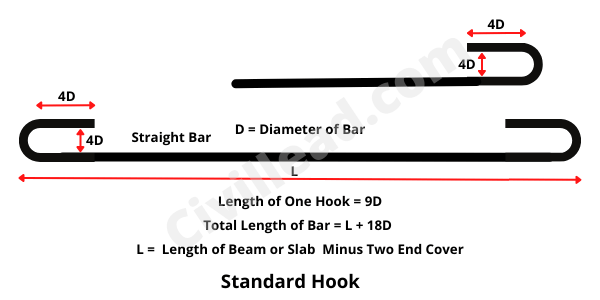
Also, Read - Difference Between Plinth Level, Sill level, and lintel level
For 45°cranked or bent up bar
The additional length for one bent up is = difference in length of hypotenuse and base
= d/sin45°- d
= d(1/0.707 – 1)
= d(1.42 – 1)
= 0.42d = 0.45d ( approx)
For two bent ups additional length is equal to 2 × 0.45d = 0.9d where d is the vertical distance between the centre of the upper and lower arms of the bent up bars, which is equal to a total depth of beam or slab minus bottom and top cover.
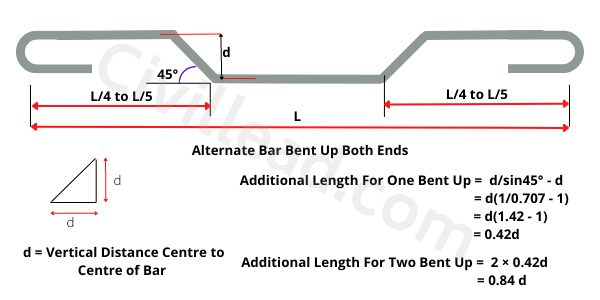
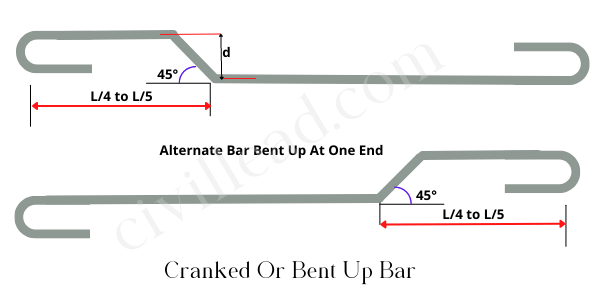
Also, Read - What is Plinth Beam? Plinth Protection, Difference Between Plinth Beam and Tie Beam.
For a 30°cranked or bent up bar
Inclined length of crank = d/sin30° = 2d
The horizontal length of crank = d/tan30 = 1.73d
The extra length required for one crank = 2d-1.73d = 0.27d = 0.3d(say)
For a bar cranked at both ends at 30 the additional length is equal to 2 × 0.3d = 0.6d
Bend Length For Stirrups
For making stirrups, we have to bend the bar at different angles such as 45°, 90 °, and 135°. Following standards are used to calculate the bend length of stirrups at corners.
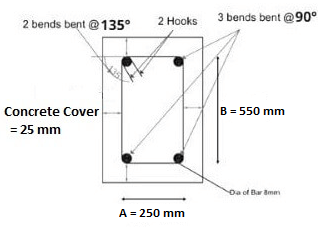
- 45° Bend length = 1d
- 90° Bend length = 2d
- 135° Bend length = 3d
Where d = Diameter of the stirrup bar
Also, Read - How to Calculate Cutting Length of Stirrups for Beam and Column?
Overlap or Lap Length at joint
The regular length of the bar is 12m. Assuming the column’s height is 20 m, and for serving this requirement, two bars of length 12m are overlapped (joined) with lap length.

Length of Hook and Total Length of Bar for different shapes
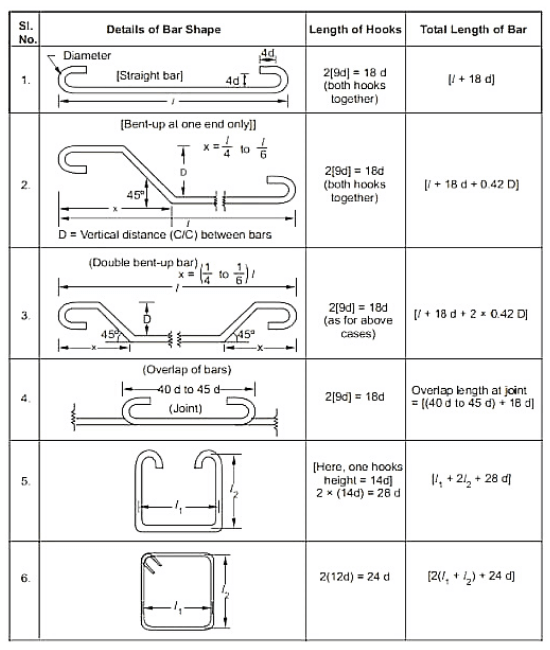
Length of Bent -up bar for 30°, 45°, and 60°
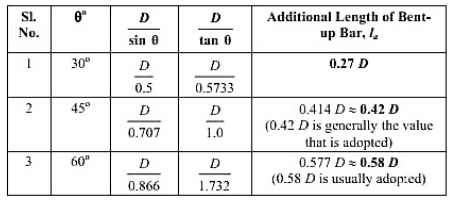
PERCENTAGE OF REINFORCEMENT ACCORDING TO CONCRETE VOLUME:
1. Lintel, Slab – 0.7 to 1%
2. Beams – 1.0 to 2.0%
3. Columns – 1.0 to 5%
4. Foundation raft, footing, etc. – 0.5 to 8%
Example – Bar Bending Schedule For Beam
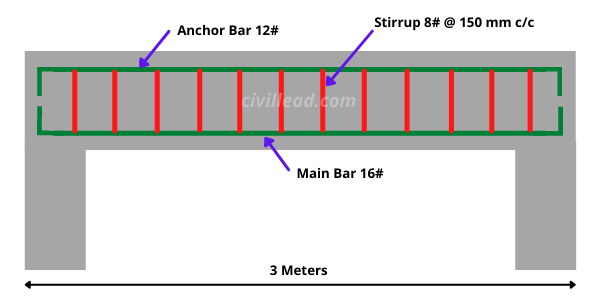
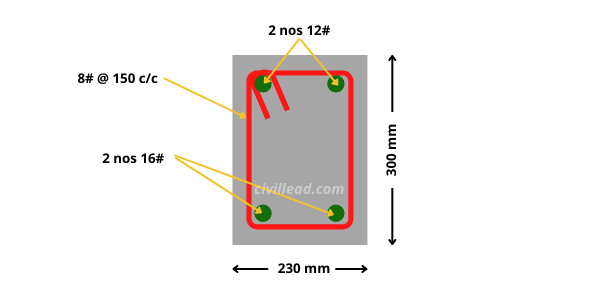
Suppose we have a beam of size 230 × 300 mm.
Main Bars = 2 nos of 16 mm
Anchor Bars = 2 nos of 16 mm
Stirrups = 8 mm dia @ 150 c/c
For preparing the bar bending schedule for the beam as mentioned above, let’s assume a clear cover of 40 mm.
Length of Main Bar
L = Total Length + 2 × 9d (hook) – 2 Cover
L = 3000 + 2 × 9 × 16 – 2 × 40
L = 3208 mm or 3.2 meters
Length of Anchor Bars
L = Total Length + 2 × 9d (hook) – 2 Cover
L = 3000 + 2 × 9 × 12 – 2 × 40
L = 3136 mm or 3.14 meters
Strriup Cutting Length
Beam Width = 230 – 2 Clear cover = 230 – 2 × 40 = 150 mm
Beam Deptrh = 300 – 2 Clear Cover = 300 – 2 × 40 = 220 mm
Cutting Length of stirrup = Perimeter + Hook Length – Bend length
= 740 + 2 × 9d – 3 × 2d – 2 × 3d
= 740 + 18d – 6d – 6d
= 740 + 6d
= 740 + 6 × 8
= 788 mm or 0.788 meters
Numbers of stirrups = (Total Length – Cover)/150 + 1
(3000 – 2 × 40)/150 + 1
19.46 + 1
20.46 say 21 nos
Bar Bending Schedule For Beam
| S.No. | Bar Description | Bar Shape | Nos of Bar | Length of Bar (m) | Total Length of Bar (M) | Bar Dia (mm) | Unit Weight (kg) | Total Weight (Kg) |
|---|---|---|---|---|---|---|---|---|
| 1 | Main Bar | 2 | 3.2 | 6.4 | 16 | 1.58 | 10.112 | |
| 2 | Anchor Bar | 2 | 3.14 | 6.28 | 12 | 0.888 | 5.576 | |
| 3 | Stirrups |  | 21 | 0.788 | 16.548 | 8 | 0.395 | 6.536 |
| 22.224 |
Common errors that should be avoided while preparing a BBS
- Miscounting of numbers of bars.
- Incorrect calculation of the bar length.
- Incorrect cover for footing, column, beam, and slab.
- Wrong counting of bend in the bar.
Bar Bending Schedule PDF
To get the bar bending schedule PDF please mail “I Want BBS PDF” to [email protected].
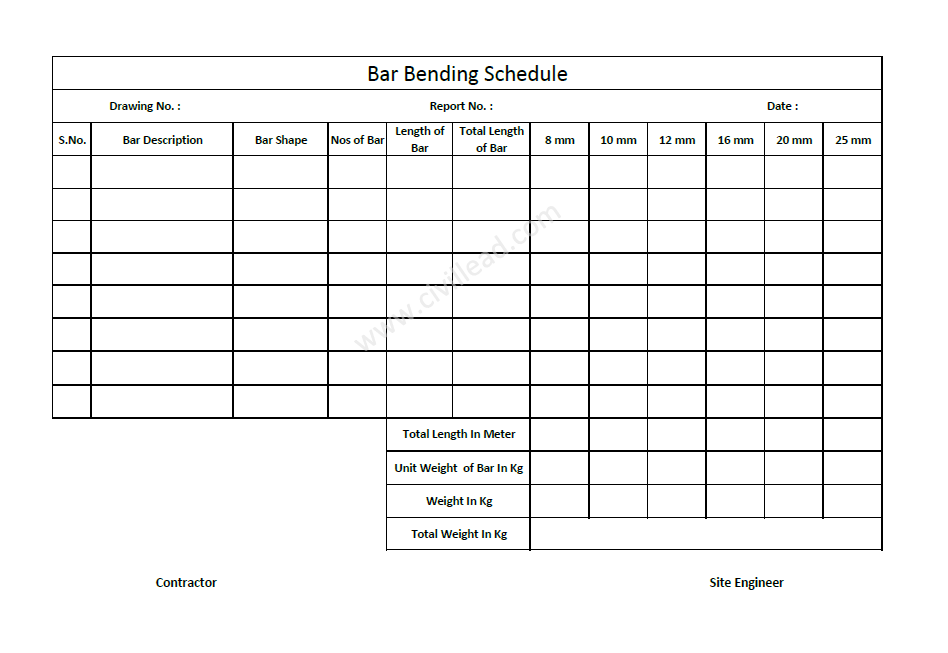
This is the complete information about the Bar Bending Schedule. If you found this information helpful please share it.
Thanks!
Also, read
How to Calculate Quantity of steel in Two way Slabs? Two Way Slab BBS
How to calculate the quantity of steel in one way slab? One way Slab BBS
Difference Between One way and Two-way Slab
Grade of Concrete and Their Uses
Concrete Mix Ratio – Types, Proportioning of Concrete Mix, and Methods
10 Best Cement Companies In India 2021